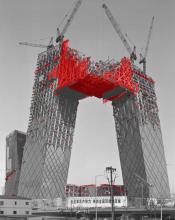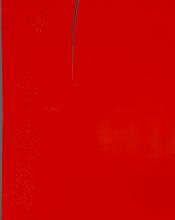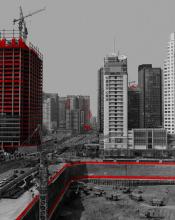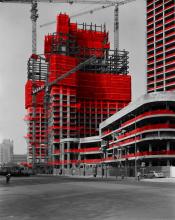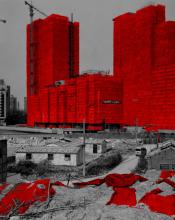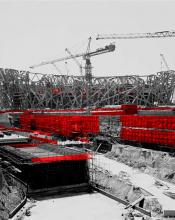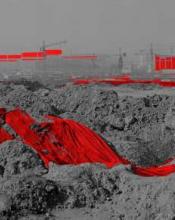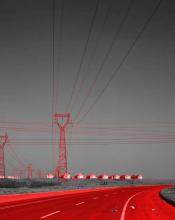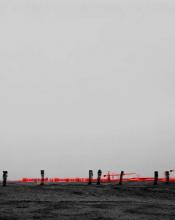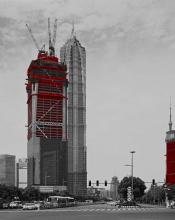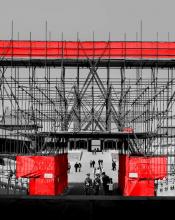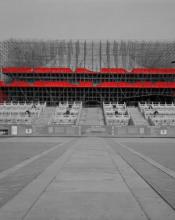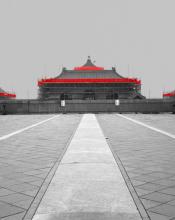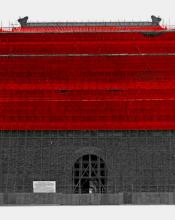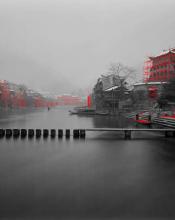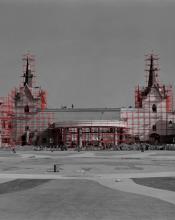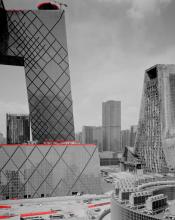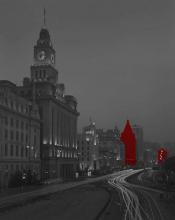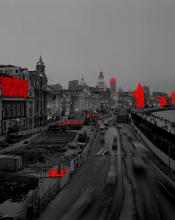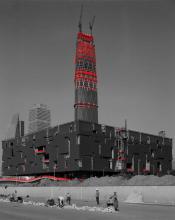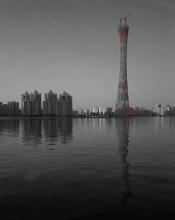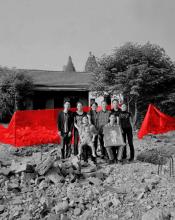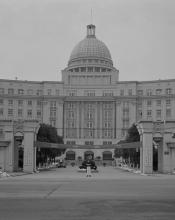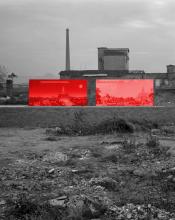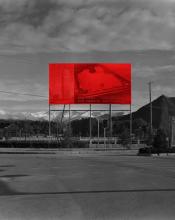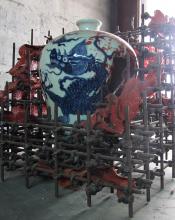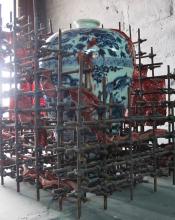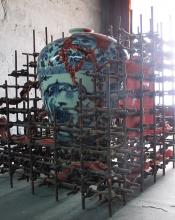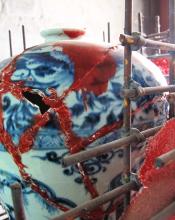Zhou Jun
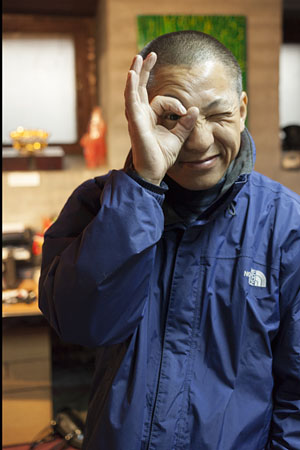
City and Construction: The Works of Zhou Jun:Zhang Zhaohui
It is virtually impossible to avoid the interference and influences that come with the process of urbanisation. Most adults have experienced it by going to a construction site to either look at or purchase an apartment. Likewise, as far as young Chinese artists are concerned, urbanisation is not only what they grew up with, but is also the backdrop for artistic creation. Nearly fifteen years ago when China’s urbanisation was in its infancy, artists had already begun to explore the relationship between the city and modern culture. Zhang Dali’s city graffiti work of the early 90s in Beijing is a good example of this, as his work subsequently inspired participation from other artists. Young contemporary artist Zhou Jun is one of those artists who, using city and city construction as his perceptual framework, explores this complex and fascinating relationship.
Growing up in Nanjing, Zhou Jun was profoundly drawn to the traditional characteristics and features of the city, while at the same time the city inspired a keen sense of Chinese traditional aesthetics. To a certain extent, his work embodies a quality of yearning for the past and broadly speaking this is a common characteristic of many artists working amidst the rich cultural and historical background of Chinese cities, such as Beijing or Shanghai. But Zhou Jun’s work emerges from city construction sites and is conceived according to his own feelings and experience thus constructing a visual narrative language of his own. He is moved by the immense swelling and expansion of Chinese cities, as well as the subversion and erosion of traditional architecture - representing Chinese culture and aestheticism - by modern industry and commerce. He uses photography to document these social phenomena and the cultural features specific to this historical period.
What sets his work apart from the rest is his use of black and white imagery and his use of red to colour certain areas of the image, specifically the scaffolding and framing in construction sites. For example, in the Hall of Supreme Harmony construction site in the middle of Beijing’s Forbidden City, the artist dyes the entire surrounding scaffolding in red. At the actual construction site itself, a life-size picture of the Hall of Supreme Harmony has been printed on the scaffolding screen in an attempt to disguise the construction site, giving visitors from all over the world a distinct visual impression of the original building. Yet in Zhou Jun’s work, this displaced scene is changed into a picture, giving the appearance of distorting history. Similar works by Zhou Jun portray the famous vaulted rotunda of Beijing’s Temple of Heaven. Manifest at the heart of these representations is how the cultural substance of classic Chinese traditional architecture has been slowly filtered and diluted through continuous renovation and urbanisation catering to tourism, the various demands of engineering projects and the process of restoration. Zhou Jun exhibits this idea by his choice of black and white imagery in an attempt to capture a yearning for the past. The red not only acts as a visual centrepiece but also provides the audience with a sense of emptiness and weightlessness. Together these characteristics act as a point of support for the viewer, impelling them to re-adjust their balance of perception and recognition.
Zhou Jun’s work, on a fundamental level, constructs a hallucinatory reality… are we in a construction site or a city? Can the memory of the cultural past and the experience of existing today be folded up together? Can the brilliance of the past extend to today? How can perceptions of the present be wrong now? What influence will past and present experiences have on the future? Beijing is a major world metropolis rapidly rising from the ruins of traditional culture and the concrete of construction sites. With the Olympics rapidly approaching, there is an attempt to tell the world of the possibility of a new direction. As far as those artists amongst us with certain life experience are concerned, this situation of evolutionary development is not to be looked at with optimism. You could say almost with certainty that within the confines of this modern city construct, the life experiences and cultural identification of this generation of artists has been profoundly recast and reconditioned.
The colour red has always had special significance in Chinese cultural memory. On one hand, it is often used on Chinese ceremonial occasions such as weddings and festivals. But it also represents radical socialism, revolutionary communist ideology, and unchallenged governmental authority and administrative power. Therefore to many people, the colour red also represents a time in Chinese history of political bloodshed and social turmoil. Because of this, the wide variety of perspectives and narrative backgrounds of each person means completely different feelings and reactions are aroused by the colour red. Therefore, the partnership between the black and white scenes and the red highlights of construction sites and city images opens up a space to the audience, giving each individual room to come to their own interpretation and produce their own meanings.
Therefore, as you look at Zhou Jun’s works, you might regard Beijing and Shanghai’s sprawling building sites and myriad construction scenes as similar to a gigantic stage where actors fervently rehearse and put on make-up in preparation for a performance to impress the world.
This is what a city is like. This is also what the history and reality of China has always been like.
(Spring 2007, Beijing)
|
1965 |
Born in Nanjing |
|
1990 |
Graduated from the Department of Photography at the Art School of Nanjing Normal University |
|
Present |
Lives and works in Beijing |
Solo Exhibitions
|
2012 |
Zhou Jun, Damien Minton Gallery, Sydney |
|
2010 |
Red Reconstructs, Studio Rouge, Shanghai |
|
|
The Red and the Black, Paris Beijing Photo Gallery, Paris |
|
|
Red Hot and Grey, Louis Vuitton, Hong Kong |
|
|
Control Lost, Zhou Jun Photography, Red Gate Gallery |
|
2008 |
Bird’s Nest Project, Rossi & Rossi, London |
|
2007 |
Zhou Jun, Red Gate Gallery |
|
2006 |
Red Wrap, Studio Rouge, Shanghai |
|
|
Red Future, 798 Red T Space, Beijing |
Group Exhibitions
|
2018 |
Cracked – Porcelain, Red Gate Gallery |
|
|
2D vs 3D, Red Gate Gallery |
|
|
798, We Are Back, Red Gate Gallery |
|
2017 |
Red Gate on the Move, Red Gate Gallery |
|
2014 |
ST.ART – Chinese Contemporary Ceramic Art, Today Art Museum, Beijing |
|
2012 |
Two Generations - 20 Years of Chinese Contemporary Art Australian Tour: City of Sydney Chinese New Year; Manning Regional Gallery; Damien Minton Gallery; University of Newcastle Gallery; Melbourne International Fine Arts (MiFA); Linton & Kay, Perth |
|
|
Beijing Hao - Six Chinese Photomedia Artists, UQ Art Museum, Queensland |
|
2011 |
20 Years - Two Generations of Artists at Red Gate, island6 Art Center, Shanghai |
|
|
20 Years - Two Generations of Artists at Red Gate, Red Gate Gallery |
|
2009 |
China Form, Red Gate Gallery |
|
2008 |
A Different Take, Red Gate Gallery |
|
|
Red Gate Stars, Red Gate Gallery |
|
2006 |
From China, Chinese Artist Residency at the 798 / Red Gate Gallery |
|
|
Size Decides Attitude, First “5×7″ Picture-Taking Biennale Project, Pingyao |
|
|
Ziboy Photography, Dimension Art Center, Beijing |
|
1992 |
Zhou Jun Photography Invitational, Nanjing Normal University, Nanjing
|
Collections
USC Pacific Asia Museum; The Opposite House, Beijing; The Peninsula Hotel, Shanghai; Private collections
The three decades of development China is experiencing – building to a crescendo with the Olympics – are unparalleled in history. The colour red, which I use to highlight specific parts of the photograph, can elicit different responses in people from different countries or cultures – at times, it can even have opposite meanings for people. I want my work to be interpreted differently by people depending on their response to the symbolic meaning of red. In this sense, the work has the potential to reveal international perspectives to common subject matter.

